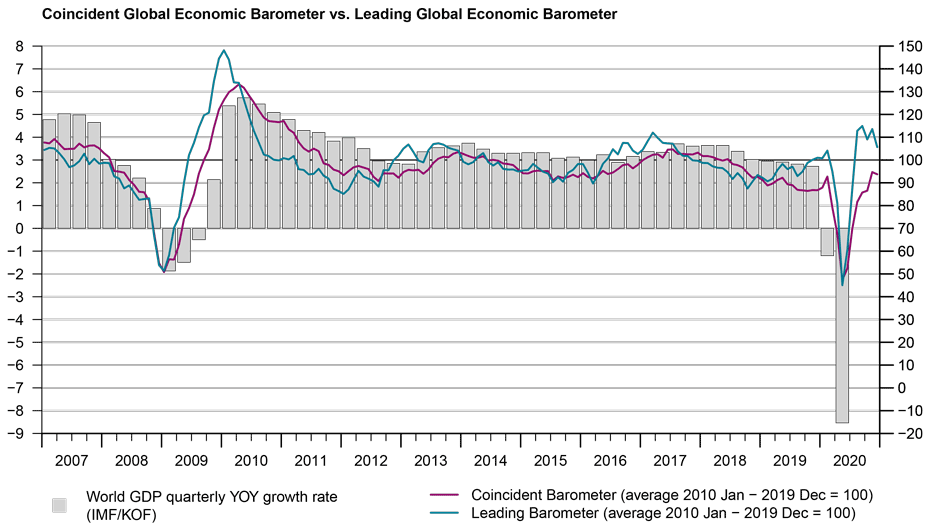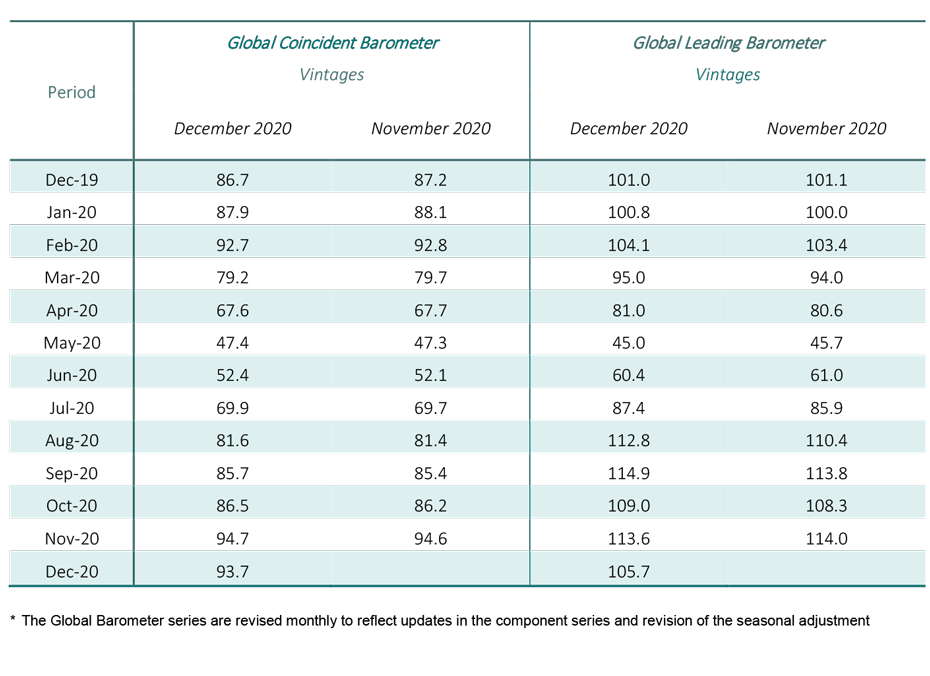Global Barometers signal slowing world recovery
The Coincident and Leading Global Economic Barometers show a deceleration in the rate of recovery of world economic activity in December, reflecting the arrival of a second wave of COVID-19 in various countries. The Coincident Barometer interrupts its sequence of increases. The Leading Barometer, which showed optimism in the previous months, is moving towards its long-term average.
The Coincident Global Barometer drops by 1.0 point in December, from 94.7 to 93.7 points, after six consecutive gains. The Leading Global Barometer falls by 7.9 points to 105.7 points. The indicator has been fluctuating since September, but this month’s decrease has been more pronounced, also leading to a drop in the quarterly moving average. The Western Hemisphere moved opposite to the other regions as well as the aggregate and contributed positively to the Coincident Barometer. All regions contribute negatively to the aggregate results of the Leading Barometer.
“The development of the barometers reflects the uncertainty that currently prevails. On the one hand, the promising reports on the production of vaccines raise hopes for an upcoming economic recovery. On the other hand, the second wave of the pandemic has many countries firmly in its grip – especially in the European region. This is reflected in particular by the development of the Leading Barometer, which has decreased in December in almost all sectors, with the strongest negative contribution coming from Europe,” concludes Jan-Egbert Sturm, director of KOF Swiss Economic Institute.
Coincident Barometer – regions and sectors
The Coincident Barometer for the Asia, Pacific and Africa as well as Europe regions drops in December, contributing negatively with 0.4 and 0.9 points, respectively, to the result of the general indicator. The increase in the Western Hemisphere continues, but at a progressively lower rate. This month, the region contributes positively to the aggregate result with a rise of 0.3 points. The graph below illustrates the contribution of each region to the deviation of the Coincident Barometer from the historical average of 100 points.
The largest sectorial contribution to the decrease in the Coincident Global Barometer in December comes from Industry, which, nevertheless, sustains the highest barometer value among all sectors. Most other sectors contribute slightly positively, while Services remain stable and Trade decline.
Leading Barometer – regions and sectors
The Leading Global Barometer leads the world economic growth rate cycle by three to six months on average. In December, all the regions contribute negatively to the aggregate result, with the largest negative contribution coming from Europe, reflecting the second wave of COVID-19 and its consequences for the recovery of the region’s economies. The second strongest contribution stems from Asia, Pacific and Africa followed by the Western Hemisphere.
In December, the Leading Barometer values for all sectors fell, except the Services sector. The set of variables reflecting the aggregated development of economies (Overall Economic Development) is the most optimistic sectorial barometer, with a value of 114.0 points, followed by Industry (111.6 points), Construction (109.5 points) and Services (105.1 points). Wholesale and retail Trade is the least optimistic sector at the moment, with a value of 85.1 points.
Industry has contributed the most to the decline of the aggregate indicator this month, with almost 6.0 points. The set of variables reflecting the aggregated development of economies (Overall Economic Development) and wholesale and retail Trade contribute 1.0 points, followed by Construction, which contributes modestly. Services was the only sector to contribute positively, albeit with little significance.
The full press release with table and graphs can be found Download here (PDF, 566 KB).
More information on the Global Economic Barometers can be found here.
The Global Economic Barometers
The Global Economic Barometers are a system of indicators enabling timely analysis of global economic development. They represent a collaboration between the KOF Swiss Economic Institute of the ETH Zurich in Switzerland and Fundação Getulio Vargas (FGV), based in Rio de Janeiro, Brazil. The system consists of two composite indicators, the Coincident Barometer and the Leading Barometer. The Coincident Barometer reflects the current state of economic activity, while the Leading Barometer provides a cyclical signal roughly six months ahead of current economic developments.
The two Barometers comprise the results of economic tendency surveys conducted in more than 50 countries with the aim of achieving the broadest possible global coverage. The advantages of economic tendency surveys are that their results are usually readily available and are not substantially revised after first publication.
The Coincident Barometer includes more than 1,000 different time series, while the Leading Barometer consists of over 600 time series. Cross-correlation analysis is used to decide which individual time series are included in the barometers. This involves correlating the individual time series with a reference series. The reference series used is the year-on-year growth rate of global gross domestic product (GDP), where the individual national GDPs are aggregated at purchasing power parity to form global GDP. A time series is only included in a Barometer if it shows a sufficiently high correlation and a suitable synchronization or lead with the reference series. The time period used for this correlation analysis currently runs from January 2010 to December 2019.
The series of the two Barometers are revised each month at publication and are standardized to have a mean of 100 and a standard deviation of 10 for the 10-year period previous to the most recent observations.

